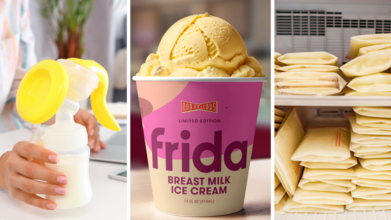- Health Conditions A-Z
- Health & Wellness
- Nutrition
- Fitness
- Health News
- Ayurveda
- Videos
- Medicine A-Z
- Parenting
- Web Stories
Replace Your Snacks With This Tree Nut To Cut Down Your Cholesterol

Credit: Canva
Replacing your usual snack foods with pecans could lead to better heart health, according to a new study by researchers at Penn State’s Department of Nutritional Sciences. The study found that adults who ate pecans daily in place of typical snacks like chips or sweets showed improved cholesterol levels and overall diet quality. Pecans are a type of hickory tree that is native to US and Mexico.
Published in the American Journal of Clinical Nutrition, the study focused on 138 adults aged 25 to 70 who were either living with or at risk of developing metabolic syndrome. This condition includes a group of health issues—such as abdominal obesity, high triglycerides, low HDL (good cholesterol), high blood pressure, and elevated blood sugar—that increase the risk of chronic diseases, including heart disease.
How Was The Study Conducted?
Participants were divided into two groups: one was instructed to consume two ounces (about 57 grams) of pecans daily in place of their usual snacks, while the other group continued with their regular diet. At the end of the study, those in the pecan group showed significant improvements in cholesterol levels and better adherence to the Dietary Guidelines for Americans—about 17% higher than the non-pecan group.READ MORE: Rose Tea Has Benefits Beyond Ayurveda: Here's How To Make It
“Replacing typical snacks with pecans improved key risk factors for heart disease including blood cholesterol levels and diet quality,” said Kristina Petersen, associate professor of nutritional sciences at Penn State and co-author of the study. She added that the improved nutrient intake among pecan eaters—especially increased fibre, polyunsaturated fats, and polyphenols—likely contributed to the reduction in LDL, or “bad” cholesterol.
Pecans are rich in polyphenols, which are natural compounds known for their anti-inflammatory properties. While earlier studies have linked polyphenols to improved vascular function, this particular study did not find significant differences in vascular health between the two groups. Still, researchers believe that increasing polyphenol-rich foods such as nuts, fruits, vegetables, and whole grains can play a meaningful role in promoting heart health.
The findings contribute to a growing body of research supporting the cardiovascular benefits of nuts. According to Petersen, this study also offers practical insight into how adults can make small but impactful dietary changes. "These results add to the large evidence base supporting the cardiovascular benefits of nuts and provide real-world ways to improve diet quality," she said.
Nutritional Profile Of Pecans
Calories: 196
Protein: 2.5 grams
Fat: 20.5 grams
Carbs: 4 grams
Fiber: 2.7 grams
Copper: 38% of the Daily Value (DV)
Thiamine (vitamin B1): 16% of the DV
Zinc: 12% of the DV
Magnesium: 8% of the DV
Phosphorus: 6% of the DV
Iron: 4% of the DV
READ MORE: Can The New Weight Loss Drugs Really Keep The Weight Off?
Breast Milk Ice Cream Hits The Shelves, But Do Adults Really Need It?

Credits: Frida, Canva
Have you heard yet? The Breast milk ice cream by OddFellows and Frida is the hottest talk of the town. While the ice cream is actually not made with real breast milk, the taste is said to mimic it. It is a bit sweet, a bit salty and has hints of honey with a "dash of colostrum", states Frida's website. According to Frida's official press release, the company wanted to answer the question that everyone "secretly wondered": What does breast milk actually taste like?
The Press Release read, as published by People, "The ice cream will be a pitch-perfect representation of the sweet, creamy, nutrient-packed goodness we’ve all wanted to try but have been afraid to ask about. It will include some of the same nutrients — fats (Omega-3 brain fuel!), carbs (energy-boosting lactose), important vitamins (iron, calcium, vitamins B and D, and zinc), plus lots of H2O for hydration."
While the ice cream may not have been made from actual breast milk, many adults consume breast milk for purported health benefits. As per a 2015 study published in the Journal of the Royal Society of Medicine, adults are buying breast milk from online market. It is marketed as "super food" and has emerged as a craze among adults.
The study notes: "While breast milk has long been promoted as optimal for infant nutrition, among CrossFit, BodyBuilding, Palaeo and other fitness communities, fetishists, chronic disease sufferers and even foodies, breast milk is in demand. In the UK, breast milk ice cream is for sale. In the USA, a lollypop company sells a breast milk-flavoured sweet. Primarily, though, the milk is sold in its raw state, ready to drink."
But, is it really that necessary for adults to consume this "super food" made for the babies? Do fitness freak really need breast milk for muscles? To know answers to these questions, we spoke to Ms Edwina Raj, Head of Services, Clinical Nutrition & Dietetics at Aster CMI Hospital, Bengaluru.
Raj says that there is no scientific evidence that breast milk provides unique muscle gain or recovery benefits for adults beyond what regular protein sources offer.
Is Breast Milk For Adults?
"While it [breast milk] contains proteins, carbohydrates, fats, and growth factors ideal for infants, the protein content is relatively low compared to whey, casein, or plant-based protein powders commonly used by athletes. Claims that breast milk boosts performance often stem from its association with growth-promoting compounds for babies, but these do not have the same impact on fully developed adult bodies," explains Raj.
For adults, the muscle gain actually relies on adequate protein intake, balanced diet and proper training.
Do Adults REALLY Need This "Super Food"?
The main claim that makes breast milk so enticing even to adults is that it provides all essential nutrients for one to sustain. However, explains Raj, the nutrients in breast milk can be matched. Though, she agrees that it cannot mimic the benefits of immunonutrients. However, Raj says that other key components like proteins, healthy fats, carbohydrates, vitamins, minerals, and beneficial compounds are all readily available in a balanced diet.
For example, high-quality protein from eggs, dairy, lean meats, legumes, and whey supplements can exceed breast milk’s protein content, while omega-3 fatty acids from fish, flaxseeds, and walnuts offer equal or greater heart and brain benefits. Vitamins and minerals found in breast milk can be obtained from fruits, vegetables, whole grains, and fortified foods. Even immune-supporting and gut-friendly compounds can be obtained through probiotics, prebiotics, and nutrient-rich foods.
Raj says, "[Breast milk] it doesn’t offer any essential nutritional benefits to healthy adults that they can’t get from regular foods or supplements. Its proteins, healthy fats, vitamins, and minerals can all be obtained from a balanced diet, and the immune-boosting antibodies in breast milk are most effective for developing infant immune systems, not fully matured adult ones."
Hygiene Issues
For products like breast milk ice cream, strict hygiene and safety checks are essential to ensure it’s safe for adult consumption.
Raj notes that the donor must be screened for infectious diseases such as HIV, hepatitis B and C, syphilis, and other transmissible illnesses, similar to blood donation protocols.
Although breast milk flavoring ingredient may be of small amount but the milk should be collected using sterile equipment, handled with gloved hands, and stored at safe temperatures to prevent bacterial growth.
"Pasteurization is crucial to kill harmful bacteria and viruses without significantly altering nutritional content. Production facilities must follow food safety regulations, including contamination control, regular microbial testing, and proper labelling," she says.
Consumers should only source such products from regulated, tested suppliers, as untested breast milk can carry serious health risks for adults.
Talking about the breast milk flavoured ice cream, she says, "Breast milk flavored ice cream can shock the consumer yet cannot be superior to what a balanced adult diet can provide, and the immune-boosting properties mainly benefit infants, for its benefit in adults are yet to be studied."
"As long as it’s made under strict safety standards, it can be a quirky treat but not a game-changer in adult nutrition," she says.
This Naturally Occurring Molecule May Have Ozempic-like Benefits Without The Side Effects

Credits: Canva
What if we tell you that a naturally occurring molecule can do wonders like Ozempic, but without the side effects. Hard to believe, isn't it? However, Stanford Medicine researchers have found a molecule that acts similar to semaglutide, by suppressing appetite and reducing body weight. The trials on animals have also shown that it worked without some of the drug's side effects, including nausea, constipation and significant loss of muscle mass.
The paper was published on March 5 in Nature, and led by Laetitia Coassolo, PhD, Kartin Svensson, assistant professor of pathology.
What Is This Naturally Occurring Molecule?
This newly discovered molecule is BRP. This acts, though, in a separate pathway, but has similar metabolic effects. It can activate different neurons in the brain and offer a more targeted approach to body weight reduction.
Stanford Medicine's release quoted Svensson, PhD, who explained, "the receptors targeted by semaglutide are found in the brain but also in the gut, pancreas and other tissues. That’s why Ozempic has widespread effects including slowing the movement of food through the digestive tract and lowering blood sugar levels. In contrast, BRP appears to act specifically in the hypothalamus, which controls appetite and metabolism.”
Svensson has also co-founded a company to launch clinical trials of the molecule in humans in the near future.
How Was The Study Conducted?
This study would not have been possible without the help of AI, notes the release. Researchers used AI to sift through dozens of proteins in a group called prohormones.
Prohormones are molecules that do not do anything on their own at first. They become active only after being cut into smaller pieces, called peptides, by other proteins. Some of these peptides then act as hormones, controlling important functions in the body, such as energy use in the brain and other organs.
Each prohormone can be cut in different ways, producing many possible peptides. Among these, only a few actually work as hormones, while most are just byproducts of protein breakdown. Traditional lab methods make it hard to find the useful peptides in this mix.
The researchers focused on an enzyme called prohormone convertase 1/3, which cuts prohormones at specific points in the amino acid chain. This enzyme has been linked to obesity in humans. One of the peptides it produces is GLP-1, which helps control appetite and blood sugar levels.
The drug semaglutide works by mimicking GLP-1. The team wanted to see if there were other peptides from this enzyme that also play a role in energy metabolism.
To do this, they created a computer program called Peptide Predictor. Instead of manually sorting through proteins, the program scanned all 20,000 human protein-coding genes to find likely cutting sites for prohormone convertase 1/3. They focused only on proteins that are secreted outside the cell, a key feature of hormones, and that had at least four cutting sites. This narrowed the list to 373 prohormones.
The program predicted that these could produce 2,683 unique peptides. The team then looked at those most likely to act in the brain and tested 100 of them, including GLP-1, on lab-grown nerve cells.
GLP-1 increased cell activity about three times compared to normal cells, as expected. But one small peptide, just 12 amino acids long, increased activity tenfold. They named it BRP, based on the name of its parent protein BRINP2.
What Did The Result Reveal?
Tests on lean mice and minipigs showed promising results. An injection of BRP before feeding reduced food intake by up to 50% over the next hour. In obese mice, daily injections for two weeks led to an average weight loss of 3 grams, mostly fat, while untreated mice gained about 3 grams. The treated mice also had better blood sugar control.
Importantly, BRP did not change the animals’ movement, water intake, anxiety levels, or digestion. It also works through different brain and body pathways than GLP-1 or semaglutide, which could make it useful for people who do not respond well to those drugs.
What's Next?
Researchers now want to find the exact cell receptors BRP binds to and figure out how to make its effects last longer in the body. If it proves safe and effective in humans, BRP could offer a new option for treating obesity.
The study was a collaboration between scientists at the University of California, Berkeley, the University of Minnesota, and the University of British Columbia.
With The FDA Banning Food Dyes, Here's A Natural Alternative To Use

Credits: Canva
As the U.S. Food and Drug Administration (FDA) moves to ban certain synthetic food dyes, consumers are turning their attention to natural options. One vibrant contender is blue spirulina, an eye-catching, plant-based pigment that has found its way into smoothies, candies, beverages, and even gourmet salad dressings.
The History and Science Of The Color
Blue spirulina is an extract of green spirulina, a type of blue-green algae classified as cyanobacteria. Its intense color comes from phycocyanin, a potent antioxidant not found in land plants. While spirulina itself has been consumed in various cultures for centuries, the blue variety gained FDA approval as a food color additive in 2013 for use in candy and gum.
Approval has since expanded to include non-alcoholic drinks, condiments, dairy alternatives, seasoning mixes, salad dressings, and certain low-alcohol beverages.
NASA once studied spirulina as a space food supplement, thanks to its nutrient density and antioxidant properties. However, dietitians caution against assuming blue spirulina is a nutritional powerhouse in large doses. “There are some benefits, but the hype is largely due to its Instagram-worthy color,” says Caroline Thomason, a Washington, D.C.-based dietitian, as reported by USA Today.
Safety and Regulation
Any color additive sold in the U.S. must undergo FDA evaluation before hitting the market. The agency’s approval indicates that the benefits outweigh potential drawbacks, but does not guarantee absolute safety. Blue spirulina is classified as a color additive exempt from certification, meaning each batch does not require individual testing before sale.
This exemption raises quality concerns. Harvard Health notes that products can vary in purity, and some may not contain the promised levels of spirulina. Contamination is another risk. Between 2018 and 2020, three blue-green algae products—two supplements and one beverage—were recalled for containing unsafe levels of microcystins, natural toxins that can damage the liver and kidneys.
“It’s generally safe in small amounts, though the quality can vary between brands,” says Thomason. “Choose a reputable source to avoid contamination with heavy metals or toxins, which can happen in poorly regulated algae products.”
Nutritional Value and Limits
While whole spirulina offers a rich profile of protein, vitamins, and minerals, the blue extract contains fewer nutrients. Still, it delivers antioxidants that may help reduce inflammation, similar to those in blueberries or red cabbage.
Adding blue spirulina to foods and drinks can be a fun way to experiment with color and flavor. However, Thomason warns that treating it like a miracle superfood can backfire. “As with any trendy health ingredient, going overboard might lead to nutrient gaps or an unhealthy fixation,” she says.
With the FDA’s crackdown on synthetic dyes, blue spirulina stands out as a visually stunning, naturally derived option for coloring foods.
If you plan to incorporate it into your meals, do so occasionally, and after consulting an expert and source it from trusted brands.
© 2024 Bennett, Coleman & Company Limited

